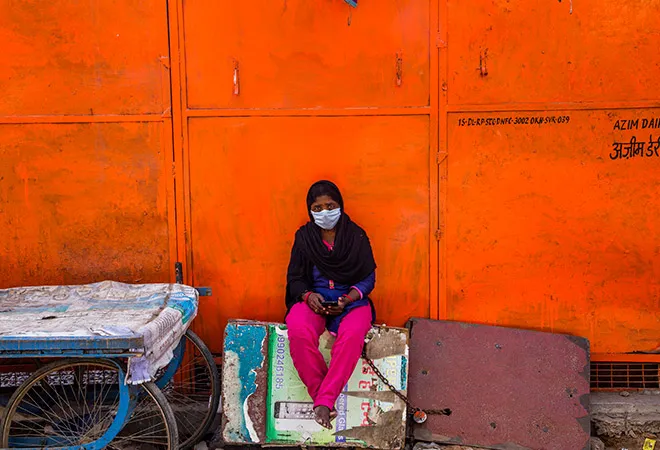
Readjustment in Chinese domination
The COVID19 crisis has revealed many fractures in the world economy, labour markets and health systems like never before. The pandemic has already changed the migration dynamics and openness of nations, and will also dictate how the global labour markets would operate henceforth. Given the sudden expansion in digitalization and remote working in all domains, regular processes of industrialisation and economic growth structures limited to transitions from primary to secondary to tertiary sectors will be revamped. There is no doubt that the human capital base of a country and associated skilling initiatives will be regarded as the most essential asset in the near future — which will be able to effectively operationalise the other forms of capital, namely, the physical, social and natural resources. In this regard, the competition between the international labour market forces in India and China is bound to assume significance in the times to come.
Containing the virus will undoubtedly be the chief priority of nations across the world in the next few months, or perhaps, even years. This will have a powerful negative impact on the demand for Chinese labour force in the international markets, since the virus was first reported in Wuhan, China, and widespread perception of it as the originating country will severely limit the inflow of human capital from China. Additionally, the ensuing strained diplomatic ties of various nations with China would add to this effect. This phenomenon could potentially lead to a substitution of Chinese labour by the Indian labour supply due to: India's advantageous demography with one of the world's largest working age populations; it's natural comparative advantage in the IT and services sector, given digital trade will be enhanced significantly post the pandemic; and finally, India's amicable diplomatic ties with the major investing countries worldwide.
For quite some time now, India is looked upon as the major balancing force against China in the global context. India’s rise, both economically and politically, was expected to not only mitigate China's prowess in the Indo-Pacific where it regularly challenges the international norms, but also to keep China from dominating the global value chains amidst a gloomy world economic scenario. While the ASEAN and Japan strongly backing this agenda, it was expected that there would be a shift of manufacturing hubs from China to India, due to the ongoing US-China trade tensions. Can India capitalise on the readjustments in the global economic order and political dynamics post the pandemic, and win the global labour market race against China?
The challenges for India
This attempt to overtake China, often called the ‘the world’s factory’, may prove to be a challenge for India for numerous reasons. Given the vastness and depth of the Chinese economy, their scale economies are almost fully utilised. There is no doubt that China is much more technologically advanced than most countries, which makes input markets more competitive than their Indian counterparts. Additionally, even though Indian labour is vastly unemployed and even cheaper than China's, the skill sets required for producing goods on the higher end of the value chain is a major impediment for the Indian labour market. In fact, if foreign investors need to hire low skilled labour, countries such as Vietnam and Thailand prove to be more price competitive in addition to lower costs of physical capital, in comparison to India.
Finally, even though India’s rank jumped up by 14 places to become 63rd out of 190 countries in the World Bank’s Ease of Doing Business Rankings 2019, it does not fare well compared to China's record low rank of 31. In the same vein, India, which is at 61.1 out of 100, also lags behind China, which is at 73.2 out of 100, on the global Sustainable Development Report Scores 2019. The UN Sustainable Development Goals are high in terms of global credibility, and are considered to be a holistic framework of development – progress towards these goals are a major enabler of attracting Foreign Direct Investment and improving the Ease of Doing Business of a nation.
India’s future growth potential
Against this background, it is important to deliberate on how India should work on its current labour market characteristics to make it more attractive in the global game. Even though India has a large working age population, Labour Force Participation Rates (LFPR) continue to dwindle and unemployment rates continue to rise. According to labour statistics from OECD, India’s working age population is at 66.4 percent of the total population as of 2018. However, the Periodic Labour Force Survey (PLFS) 2017-2018 of India shows that among persons of age 15 years and above, LFPR in India was at 49.8 percent: it was 50.7 percent in rural areas and 47.6 percent in urban areas. India’s unemployment rate has increased from 3.0 percent to 7.1 percent for urban men, and from 5.2 percent to 10.8 percent for urban women between 2012 to 2018.
While skilling in the technology and virtual space is important in order to capitalise on the predicted digital boost, it is important to address the lack of digital access for a large portion of the Indian population. Vocational courses through skill development missions must account for the future of work. According to the India Skills Report 2019, 40-50 percent of “existing jobs which are transaction heavy will get automated” – these include, financial services, manufacturing, transportation, packaging, and shipping. These numbers may grow larger due to the trial digital runs that the pandemic has prompted. Existing companies, to prevent job loss, must initiate mandatory programs to help employees acquire new digital skills. According to the Human Development Report 2019, however, inequality in terms of technology is immense, where number of households with access to digital devices are still very low - only 32 percent households have access to computers. This divide in skilling and access must be bridged for India to be able to partake in the digital revolution that has begun.
Despite India's macroeconomic policies to enhance its labour market, economic health and competitiveness, the fact that a majority of the nations will try to insulate themselves in the short-run post the COVID19 emergency, will lead to tremendous demand-supply imbalances in the international markets. However, as China's ambitious Belt and Road Initiative (BRI) has felt tremors due to legitimate uncertainties about its future, it is time for India to increase the efficiency of its domestic product and labour markets to structurally improve the economy in the long term. Finally, the time is also ripe for India to harness the potential of regional groupings such as the ASEAN, SAARC and BIMSTEC to tide through the troubled waters of the global financial crisis we are expected to run into right after the immediate health emergency is somewhat under control.
The views expressed above belong to the author(s). ORF research and analyses now available on Telegram! Click here to access our curated content — blogs, longforms and interviews.




 PREV
PREV



